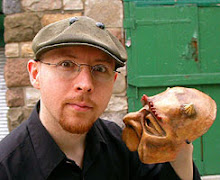
Hello all.
Over the years, the frequency of puppets requiring mouth plates has increased in my production. I've been trying different types of mouthplate materials, and I really like one material above all else for a hinge material: nylon webbing (backpack straps). This article shows what I do with it, to make a mouth plate.
The design is symmetrical, and can be worn on the left or right hand. Very comfortable, if glued well-aligned with the mouth. The center zigzag stitch separates the hand grips in half. This piece was a test, and was removed because I messed up the alignment in the puppet, and the side stitches flaring out were not easily flattened down. Look below fore a better version of stitching the sides. This one is not made of nylon webbing, but it is a similar looking product, I think it's a natural fiber.
Pros: very strong, one piece, won't un-glue itself.
Cons: only works for lightweight puppets that don't require a finger grip (like a half ball).
Be careful to give enough space for fatter fingers than your customer's, just in case.
I started using this marvel stuff years ago, after having problems with a leather mouthplate stretching out of shape and ungluing itself because of extreme moisture in the air. Nylon webbing doesn't seem to stretch at all, won't rot, and doesn't seem to get brittle. It accepts hot glue wonderfully, but it drinks in contact cement a bit between its weaves, so we need to use several applications before proper surface contact is achieved. The contact cement stiffens the hinge area, so don't put any where it will bend.
More often than not, I can't find the webbing in a wide enough variety, so I use two or more next to each other, to create the proper hinge width. I nowadays zig-zag stitch them flat next to each other, using the sewing machine. I picked up that trick from a customer who is very good at sewing, when she learned that I was going to have to use the narrower webbing for some puppets I was making for her. Been zigzagging it ever since! Once stitched, the hinge is measured within the head, marked, and trimmed. The perimeter is zigzag stitched twice to prevent unraveling. Might not be necessary, with the contact cement later, but I prefer to play it safe.
The webbing can be somehow uncomfortable at the edges, so once installed in the mouth, covering with a soft but durable fabric will increase comfort and durability. Sometimes the design requires finger tubes, so I make these out of the same nylon webbing, but make sure to machine stitch it flat, then loop the lengths on both side up and hand-stitch them together once I have the required fit. Be careful not to stitch too thickly where the webbings link with each other, or you'll have an uncomfortable bump.

The middle finger is free to operate one of my eyebrow triggers.

What an actual nylon webbing hinge looks like before it is stitched together flat. The webbing I had was narrow, so I zigzagged three together (brown stitches in the center). The pins show where the zigzag stitch must be well done to ensure durability. Avoid over stitching into lumps though. The "legs" are joined together, trimmed to size, once measured, then their edges zigzagged to prevent unraveling, then each tube is hand stitched together. An extra stitch is done over that to split the hand grip in half, if necessary for the design (see first picture).
Bonus Tips:
•Nylon webbing can be made into puppet hair, by simply unraveling it. Usually, it unravels only in one direction. Some weaves of nylon webbing don't unravel in any usable way.
•Using a waterproof fabric inside the foam puppet's mouth will enhance the durability.
I made a puppet about two years ago that has a liner of umbrella fabric. It's lasting to this day.
It might be sluippery with sweat, so be sure that you have a good grip as part of the design.
I had a half ball of closed cell foam as a finger grip on the upper mouth plate.



1 comment:
Excellent!
Post a Comment